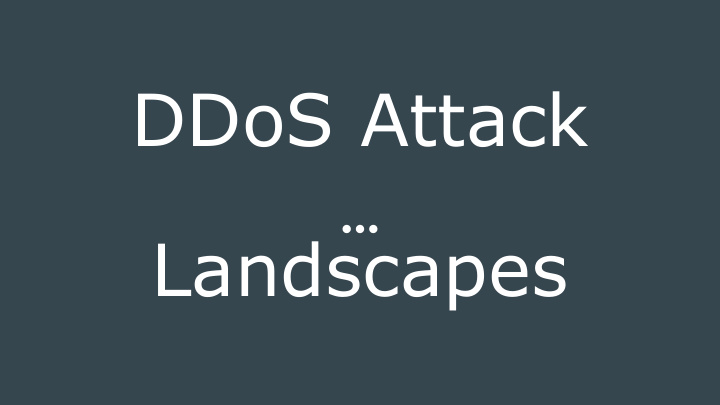



DDoS Attack Landscapes
Introduction ➔ General opinion AKA DDoS skeptics Denial of Service attacks are a fact of life on the Internet ➔ Service disruption ➔ Sometimes employed as a “smoke screen” ➔ ➔ What this talk is and what it is not Vendor independant ➔
Trends visualization Source: Akamai's State of the Internet Report
History <1999 - SYN floods, Smurf Attack, Ping of death, first distributed attack tools ('fapi') 2000 - bundled with rootkits, first botnets controlled via ÍRC 2001 - First major attack involving DNS servers as reflectors 2002 - Attacks disrupted service at 9 of the 13 DNS root servers (also 2007 & 2015). 2003 - First DDoS mitigation services arise 2005 - 8 Gbps largest attack size 2009 - Iranian election protests 2012 - Operation Ababil 2014 - 400+ Gbps largest attack size 2015 - DD4BC emerge & The Great Canon of China 2016 - 600Gbps attack against BBC 2016 - MIT DDoS
Motivation Motives: ➔ Groups ➔ Revenge ◆ Anonymous ◆ Blackmail ◆ ◆ Lizard Squad Extortion ◆ DD4BC ◆ Hacktivism ◆ Armada Collective ◆ business feud ◆ New World Hacking ◆ leveling up ◆ ◆ ...
Mechanisms why are DDoS attacks possible? ➔ volumetric attacks vs resource starvation ➔ infrastructure vs application attacks ➔ attacker bandwidth > victim bandwidth ➔ bps vs pps, packet storms ➔ stealth/creeper ➔ scouting & recruitment ➔ botnet spawned by malware ➔
Infrastructure DDoS ACK, RST, FIN , PSH, URG (Out-of-state floods) ➔ XMAS, TCP anomaly ➔ SYN ➔ CHARGEN ➔ DNS ➔ ICMP ➔ RIP ➔ SSDP ➔ NTP ➔ UDP (FRAGMENTS) ➔
UDP-based Amplification ip address spoofing ➔ Fire & Forget ➔ DNS Reflection is so 2014 ➔ NTP amplification ➔ as easy as (UDP port) 123 UDP Fragments ➔ Vulnerable services ➔ MON_GETLIST ◆ Open resolvers ◆ Source: blog.cloudflare.com
Amplification factor DNS - 28 to 54x ➔ NTP - 556.9x ➔ SSDP - 30.8x ➔ CharGen - 358.8x ➔ RIPv1 - 131.24x ➔
SSDP Flood HTTP/1.1 200 OK CACHE-CONTROL: max-age = 120 LOCATION: http://192.168.1.1:80/UPnP/IGD.xml ST: urn:schemas-upnp-org:service:WANIPConnection:1 SERVER: System/1.0 UPnP/1.0 IGD/1.0 USN: uuid:WANConnection{9679d566-230a-49d3-92e5-421e9223eaef} 000000000000::urn:schemas-upnp-org:service:WANIPConnection:1 HTTP/1.1 200 OK Cache-Control: max-age=120 Location: http://192.168.0.1:65535/rootDesc.xml Server: Linux/2.4.22-1.2115.nptl UPnP/1.0 miniupnpd/1.0 ST: urn:schemas-upnp-org:device:InternetGatewayDevice: USN: uuid:b1c5d60c-1dd1-11b2-8687-a0bc8f76d644: :urn:schemas-upnp-org:device:InternetGatewayDevice:
DNS reflection flood 04:17:11.736254 IP x.x.x.x.53 > x.x.x.x6007: 45488| 22/0/0 DNSKEY, AAAA 2600:803:240::2, A 63.74.109.2, TXT "v=spf1 ip4:63.74.109.6 ip4:x.x.x.x ip4:x.x.x.x mx a:HIDDEN 04:17:11.736257 IP x.x.x.x.53 > x.x.x.x.30267: 4354 2/2/0 NS HIDDEN . (105) 04:17:11.736276 IP x.x.x.x.53 > x.x.x.x7519: 45488| 22/0/0 Type51, RRSIG, DNSKEY, DNSKEY, DNSKEY, DNSKEY[|domain] 04:17:11.736287 IP x.x.x.x.53 > x.x.x.x.44609: 4354| 22/0/0 RRSIG, A 63.74.109.2, TXT "v=spf1 04:20:08.919421 IP x.x.x.x.53 > x.x.x.x.51286: 52156 13/4/2 SPF, DNSKEY, DNSKEY, NAPTR, TXT "v=spf1 a mx ip4:x.x.x.x/21 ip4:x.x.x.x/16 ip6:2001:04F8::0/32 ip6:xxx:xxx:xx::xx/128 ~all", HIDDEN
TCP-based attacks SYN Floods ➔ Out-Of-State Floods ➔ Rainbow/Xmas Floods ➔ TCP Anomaly ➔ TCB ➔
SYN / Rainbow floods SYN Flood 21:59:49.851423 IP X.X.X.X.33465 > Y.Y.Y.Y.80: Flags [S], seq 72209530 , win 14600,options [mss 1460,sackOK,TS val 1428345032 ecr 0,nop,wscale 3], len gth 0 21:59:49.854397 IP184.25.56.134.44560 > 178.132.241.16.80: Flags [S], seq 19937 82773, win 14600, options [mss1460,sackOK,TS val 1530530357 ecr 0,nop,wscale 3] , length 0 Rainbow flood 01:49:36.107817 IP X.X.X.X.45240 > Y.Y.Y.Y.80:Flags [SRP.UW], seq 2733393585, ack 0, win 28679, urg 0, length 0
Application layer attacks Basic HTTP Floods ➔ Randomized HTTP Floods ➔ Cache-bypass HTTP Floods ➔ GET Floods ➔ POST Floods ➔ Slow Post ➔ HTTPS floods ➔ SSL handshake / renegotiation attacks ➔
HTTP GET/POST Floods GET Flood 10:49:23.674001 IP X.X.X.X.58126 > Y.Y.Y.Y.80: Flags [P.], seq 0:28 0, ack 1, win14600, length 280 ....E..@..@.6..l@...r.I....P*.8..q+.P.9.....GET / HTTP/1.1 Accept:*/* Referer: http://www.victim.com/ Accept-Language: zh-cn Accept-Encoding: gzip,deflate User-Agent: Mozilla/4.0 (compatible; MSIE 6.0; Windows 5.1) Host:www.victim.com Pragma: no-cache cache-control: private, max-age=0, no-cache Connection:keep-alive
Detection Know your RFCs ➔ False positives vs. False negatives ➔ Anomaly detection (delta calculation) ➔ Appliances ➔ Graphs/Flow ➔ Into the hex ➔ Keen eye ➔
Packet forensics 21:28:09.101512 IP X.X.X.X.3478 > Y.Y.Y.Y.80: Flags [S], seq 8420, win 21012, options [mss 729,nop,wscale 8,nop,nop,sackOK], length 0 21:28:09.101517 IP X.X.X.X.4041 > Y.Y.Y.Y.80: Flags [S], seq 1612447744:1612447752, win 59258, options [mss 19970,nop,eol], length 8
Mitigation Techniques Rate limiting ➔ ACLs (deny tcp any any match-all +rst ) ➔ Blackholing ➔ Source Based NULL routing ➔ Stateful inspection devices ➔ SYN Cookies ➔ Signature Matching ➔ WAF ➔ Header Order ➔ DNS Truncated bit ➔ Network Ingress Filtering ➔
On-Premise vs Cloud vs Hybrid Saturation ➔ SSL Based attacks ➔ Layer 7 Floods ➔ Response time ➔ Always on mitigation ➔ Traffic divertment ➔ Tune your machines ➔
Cloud DDoS Solutions Distributed attacks require a distributed defense ➔ Industry SLA ➔ 24/7 SOCs ➔ Routes announced ➔ via BGP Leverages Anycast ➔ Tbps of dedicated ➔ attack capacity SSL? ➔ Threat intelligence ➔
Thank you for listening! Questions ?
Recommend
More recommend